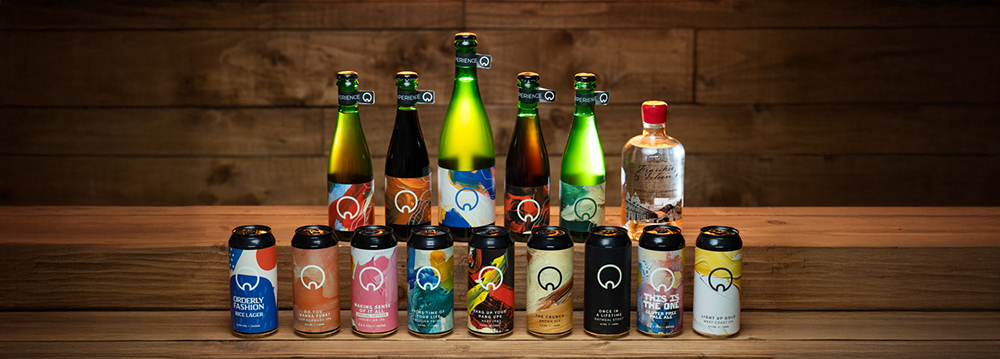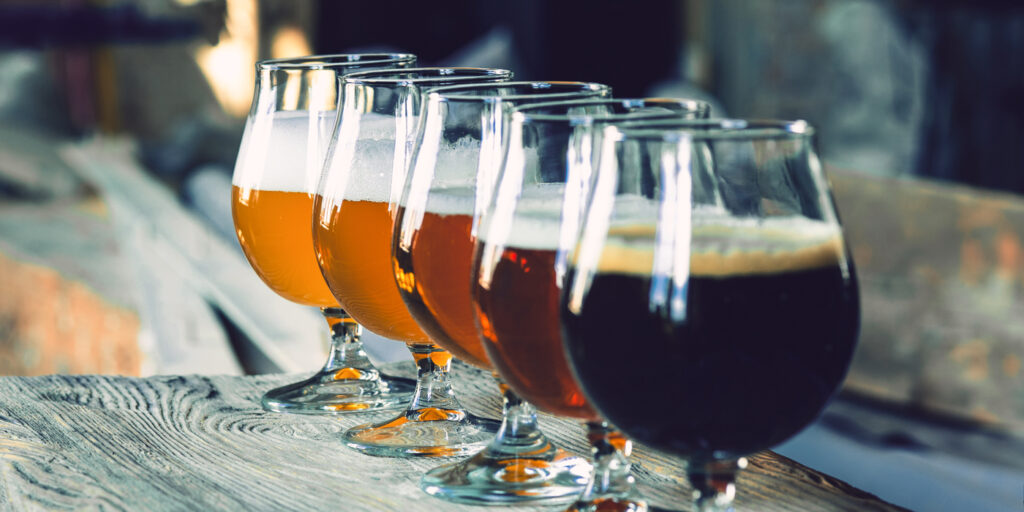How Do You Make An Award

When I attended a beer-pairing dinner at Sleepy Hollow restaurant in Newtownabbey, Northern Ireland last year, I was blown away by the range of wild fermented, barrel-aged beers being produced by Our Brewery.
Ok, look, I know I’m a little biased here, I’ve been working with the folks from Get ‘Er Brewed for more than three years after all. But that gives me a unique window into what’s happening at this small, independent Irish brewery. Not only did each beer express depth and complexity, but they worked wonderfully with the food prepared by chef Paul Dalrymple. It’s a night that will stay with me for a very long time.
It takes a lot of faith, determination and intent to make these kinds of beers. At their small production scale, and based on how popular they are in the grand scheme of things, they’re not the sort of beers I would describe as ‘commercially viable’. These are the kinds of beers you make because you want to make them. The process, especially the maturation of such beers in oak, can take months, if not years. But, if you’ve the patience, the results can be stunning.
Those of us lucky enough to be sat around a table that night knew we were onto something special. As it turns out, we weren’t the only ones. Five of Our Brewery’s six barrel aged beers, and 11 beers in total picked up a prize at the 2025 Great Taste Awards, with two claiming a two star prize, and an incredible three beers taking home a coveted three star award. Two of those beers, Low Land Oud Bruin and Razma – a Lithuanian-inspired Keptinis – are now in the running in this year’s Golden Fork Awards, which represents the pinnacle of food and drink in the UK and Ireland.
The accolades didn’t stop there either. Just a couple of weeks later Our Brewery would net a further 12 prizes at the World Beer Awards. This included two of the top ‘World’s Best’ titles – not bad for a tiny brewery in the middle of County Antrim! Unsurprisingly, Our Brewery’s barrel aged beers were once again in the mix, with Low Land once again proving victorious, and joined by the delicate-yet-complex mixed fermentation saison, Seasur.
It’s worth pausing to note that, with these accolades combined, it makes Our Brewery one of the most decorated breweries in the world in 2025. Considering the thousands of breweries that enter both the Great Taste Awards and the World Beer Awards, and the international nature of the latter, that is some going when you think about it. I know how good these beers are because I’ve tried them. If you’re reading this you should probably be trying to figure out a way to do the same.
But how do you win awards like this in the first place?

While there are various different beer awards, what specifically makes the Great Taste Awards stand out is that it’s a food competition, and not specifically about beer. This means that a lot of the judges don’t have a classic beer background, and come to the table with an open mind in terms of what they’re about to experience. With comments ranging from “ridiculously drinkable” to “divine”, it’s safe to say these judges were seriously impressed with Our Brewery’s beers.
I’ll run through the complete list of Our Brewery Great Taste Awards and World Beer Awards at the end of this post, but before that I want to talk about what makes a beer award-winning in the first place. Because if you do want to take home a prize at a competition such as this, first you must figure out how to impress the people sitting around the table judging it. To do this, you need to understand that judging beer is a completely different process – and, indeed, a totally different experience – to how you might ordinarily consume it.
Drinking beer is primarily done for relaxation and enjoyment – this goes without saying. But this is not the case at the judges table. Here is where serious business takes place. These individuals have spent a lot of time, and potentially a lot of money on training, and on honing their palates. If you want to impress these kinds of people, you need to make sure your beer is nothing short of impeccable.
But before we even consider how good a beer is going to taste, we must first consider off flavours. Skillful judges can pick out the likes of diacetyl, acetaldehyde and tetrahydropyridine like a marksman sniping the wings off a fly at 100 paces. Even if these faults exist in tiny amounts, the way each judge focuses on a particular beer means they have no chance of succeeding if any are present – and that’s before they even consider what’s good about it. It’s important to remind ourselves these judges aren’t sipping for enjoyment or relaxation, they’re here to pull your beer apart strip by strip and make sure it, at the very least, passes muster.
It’s not just how a beer tastes that’s up for analysis. Before a judge has even thought about pulling a glass to their lips, they must first assess a beer visually and aromatically. Unless it’s a particular style that leans into haze, clarity is king. Some very good beers have fallen at this hurdle and perhaps might have taken home some big prizes were they done blindfolded.
Condition is also important. Assessors are looking for sparkle, and a tight carbonation that indicates a particular beer has been fermented and matured with skill and care. Then it’s time to check on the aroma, which can often be the first indicator if a beer possesses any faults. Some reports suggest that your olfactory (that’s the part of your nasal system that detects smell) is responsible for around 75% of what you perceive in terms of flavour. Ensuring your beer has a positive aroma is also worth vital marks around the judges table.
At last it’s time for that first sip, which is typically where most points are awarded, with judges analysing both the flavour and the finish of the beer. A technique I’m personally fond of – beyond just having a good old swill – is called retronasal tasting. With this technique, after swallowing you blow firmly out of your nose with your mouth closed. This forces aromatic compounds into your olfactory, giving you a focused, direct way of interpreting a particular beer’s flavour. I’d never encourage anyone to try this down their local, but if you’re ever enjoying a bottle at home give it a try sometime. It might just surprise you in terms of how it opens up a beer’s flavour and aroma.

Finally, it comes down to the finish, which is really checking if the beer is not too bitter or astringent, (or if it’s not bitter or astringent enough.) Does a particular flavour linger for a long time, or does it disappear with a whisper?
What works here also depends on a particular beer’s style, which is an important factor to consider if you’re attempting to take home a prize. Generally speaking, all beer competitions judge to a particular set of style guidelines, such as those outlined by CAMRA, SIBA, or the BJCP. It can be worthwhile checking on this and ensuring your beer is entered in the right category. Famously, Pilsner Urquell – arguably the original pilsner – once failed to place in the pilsner category at an American competition, because the beer was too dark in colour to qualify… It can also go the other way. At last year’s World Beer Cup, Sierra Nevada Pale Ale was named champion in the ESB category!
It’s not just about brewing to style though. It’s about brewing the best possible beer you can. From my own experience, it’s actually quite rare for a beer to really stand out and wow a table of judges. Which means that when certain beers win accolades such as a three-star Great Taste award, it must be seriously good, because competition is fierce, and judges are incredibly stringent.
One other thing I consider is worth thinking about is who these awards carry meaning for. No one is checking how many awards a beer has when making a decision at the supermarket, or while waiting at the bar. But the people who put those beers there in the first place? They are definitely considering those awards, which is why they still carry value, and why they’re worth celebrating. And getting to celebrate your own hard work as a brewery? That’s a reward in itself.
Speaking of which, as promised, here’s those Our Brewery award winners in full. A massive congratulations to the team, these are very special beers, and these accolades are very well deserved indeed.
THREE STAR GREAT TASTE AWARDS
- Untamed – Barrel Aged Wild Ale V1
- Razma – Barrel Aged Keptinis Beer
- Low Land – Barrel Aged Oud Bruin Brown Ale
TWO STAR GREAT TASTE AWARDS
- Light Up Gold – West Coast IPA
- Do You Wanna Funk? – NEIPA
- Prime Time of Your Life – Belgian Triple
- Séasúr – Barrel Aged Mixed Ferm Saison
- Terra Nocturne – Barrel Aged Imperial Stout
ONE STAR GREAT TASTE AWARDS
- Once In A Lifetime – Oatmeal Stout
- Orderly Fashion – Rice Lager
- The Crunch – Brown Ale
- Frankie and Eileen’s – Craft Gin
WORLD BEER AWARDS GOLD – Ireland
- Hang Up Your Hang Ups Hazy IPA – Session
- Prime Time Of Your Life Belgian Triple – Belgian Style Triple
- Seasur Mixed Ferm Saison – Biére De Garde/Saison* (World’s Best)
- Untamed Wild Ale – Lambic
- Low Land Oud Bruin – Oud Bruin* (World’s Best)
- Humble Wild Ale – Sour & Wild Ale
- Terra Nocturne Imperial Stout – Imperial Stout
WORLD BEER AWARDS SILVER – Ireland
- This Is The One Gluten Free Pale Ale – Gluten-free
WORLD BEER AWARDS BRONZE – Ireland
- The Crunch Brown Ale – Mild
- Making Sense Of It All American Pale Ale – American Style
- Razma Barrel Aged Keptinis – Experimental
- Do You Wanna Funk? NeIPA – Milkshake IPA/New England IPA
— Matthew Curtis